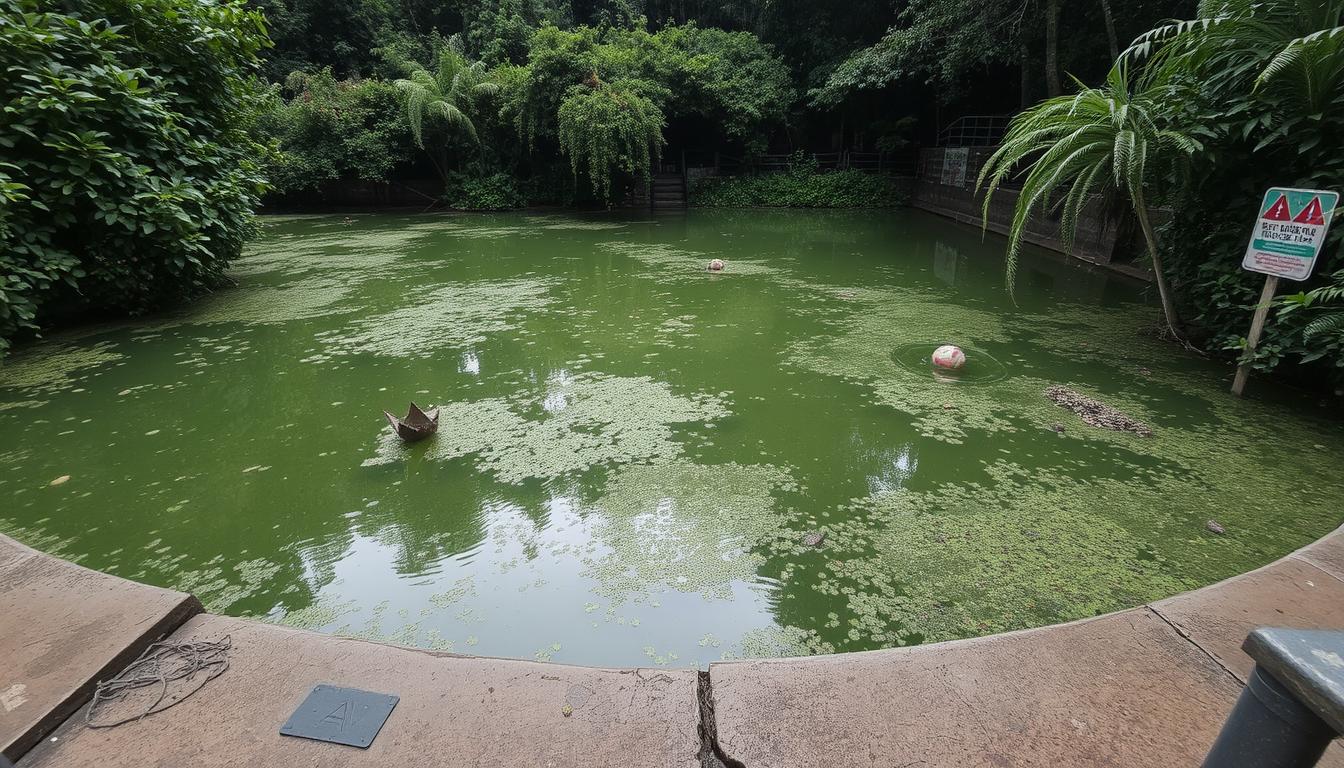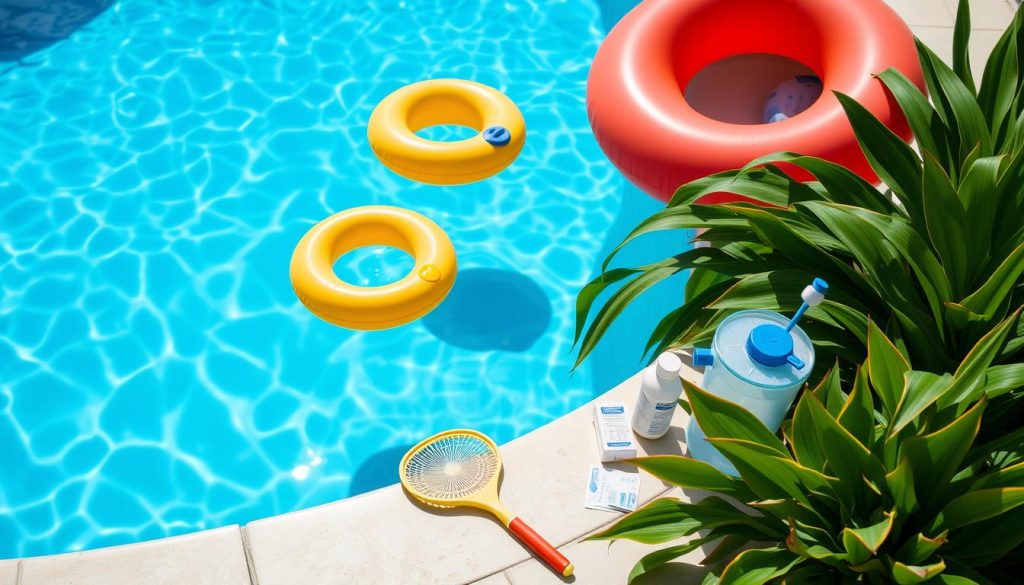
Cloudy pool water often signals algae growth, caused by insufficient sanitizer. This highlights the dangers of green pool water. Low sanitizer levels can lead to germs and viruses, threatening swimmers’ health.
Harmful microbes like Shigella, Giardia, and E.coli may lurk in green pools. These pose significant risks to swimmers. Hand, Foot and Mouth Disease can also spread in contaminated water.
Swimmers can spread germs for up to 2 weeks after having diarrhea. This increases infection risks for others. Without proper chlorine, bacteria thrive in pool water.
These bacteria can cause ear infections and eye irritation. They may also lead to lung problems and severe illnesses like Legionnaires’ disease.
This guide explores the causes of green pool water. We’ll discuss different types of discoloration and health risks. Understanding these factors helps ensure safe, enjoyable swimming experiences.
What Causes Green Pool Water?
Green pool water is a common issue for pool owners. It’s unsightly and can be harmful to swimmers. Understanding why pools turn green helps prevent this problem.
Consistent effort is key to keeping pools clear. By knowing the causes, we can develop strategies to avoid green water. These strategies also help prevent algae growth.

Lack of Chlorine in Pool Water
Chlorine is vital for a clean pool. It should be between 2.0 and 3.0 parts per million. Low chlorine levels make pools vulnerable to algae and contaminants.
Regular testing and adjusting of chlorine are essential pool maintenance tips. These steps are crucial for avoiding green pool water.
For optimal swimming pool maintenance, the free chlorine level should be maintained between 2.0 and 3.0 parts per million.
Algae Growth and its Impact on Pool Water Color
Algae thrive in warm, nutrient-rich environments like poorly maintained pools. As algae multiply, they can turn pool water different shades of green.
The color indicates the severity of the infestation. Light green shows early stages, while dark green represents extreme neglect.
- Light green pool water indicates early stages of algae growth with lower concentrations of algae and other microorganisms.
- Medium green pool water points to denser algae blooms possibly due to significant chemical imbalances or neglect over a more extended period.
- Dark green pool water represents an extreme case of neglect with high bacterial and algae levels characteristic of this stage.
Other Factors Influencing Algae Development
Besides low chlorine, other factors can cause algae growth. These include pH levels, cyanuric acid, filtration issues, and phosphates.
| Factor | Impact on Algae Growth |
|---|---|
| pH Levels | High pH levels (above 7.6) can lead to algae formation, causing pool water to appear green or cloudy. Low pH levels (below 7.2) can result in rapid chlorine dissipation, leading to ineffective sanitation. |
| Cyanuric Acid | High stabilizer (cyanuric acid) levels can slow down chlorine’s effectiveness, causing high chlorine levels that don’t clear the green color from the pool. Chlorine stabilizer levels should be maintained between 30-50 ppm before adding pool shock to ensure chlorine effectiveness. |
| Filtration Issues | Poorly performing or inadequately run swimming pool filtration systems can cause debris to remain in the water, contributing to a greenish tint. Regular maintenance and addressing issues like channeling, gasket damage, or clogged filters is crucial for preventing algae growth in pools. |
| Phosphates | Phosphate levels in pools should be kept below 500 ppb (parts per billion) to prevent algae growth. High phosphate levels can serve as a nutrient source for algae, exacerbating the problem. |
Proper chlorine levels are key to preventing green pool water. Monitoring pH and cyanuric acid is also important. Address filtration issues and control phosphate levels too.
These pool maintenance tips help reduce the risk of green water. They ensure a safe and enjoyable swimming experience for everyone.
Different Types of Green Pool Water
Green pool water comes in three categories: light green, dark green, and black green. Each type shows different algae growth levels. These levels affect swimming safety and pool maintenance needs.
Light Green Pool Water
Light green pool water is the least severe type. It often results from low sanitizer levels and poor maintenance. This type suggests a minor algae problem that’s easy to fix.
Proper cleaning techniques and restoring chemical balance can solve the issue. With quick action, you can prevent further algae growth.
Dark Green Pool Water
Dark green water shows a bigger algae problem than light green. It’s harder to clean and more dangerous for swimmers. Algae can host harmful bacteria like E-coli.
This type of water can also clog and damage pool filters. If left untreated, it may lead to costly repairs.
Black Green Pool Water
Black green water is the worst type. It has lots of algae that resist cleaning efforts. This algae can stain pool walls and floors.
Swimming in black green water is very risky. It can cause health problems and damage pool surfaces and equipment.
| Type of Green Water | Severity | Algae Presence | Health Risks | Cleaning Difficulty |
|---|---|---|---|---|
| Light Green | Low | Minor | Minimal | Relatively Easy |
| Dark Green | Moderate | Significant | Hazardous | Requires More Effort |
| Black Green | High | Extensive | Strongly Discouraged | Most Difficult |
Prevent green pool water by maintaining proper water balance and cleaning regularly. For severe cases, seek help from trained pool contractors. Flawless Image Pool Service can restore your pool to a safe condition.
Is it Bad to Swim in a Green Pool?
Swimming in a green pool is unappealing and dangerous. Algae in the water makes it hard to see underwater. This increases the risk of drowning, especially for kids and new swimmers.
Algae also shows that the pool lacks proper chlorination. Without enough chlorine, harmful germs can thrive in the water. These germs can enter your body through cuts or openings.
Safety Hazards Associated with Swimming in Green Pools
Green pools often lack enough chlorine to kill bacteria and viruses. This can lead to various illnesses and infections. Swimmers may get sick from these harmful microorganisms.
Potential Health Risks of Swimming in Algae-Filled Pools
Swimming in green pools can cause ear infections, fever, and skin rashes. In serious cases, it may lead to stomach problems. Warm, stagnant water in these pools helps harmful bacteria grow.
To keep swimmers safe, it’s crucial to maintain good pool hygiene. Proper water chemistry is also important for preventing health risks.
Damage to Pool Equipment and Surfaces Caused by Algae
Algae growth can harm pool equipment and surfaces. It can clog filters, making them less effective. This means more frequent cleaning or replacement.
Algae can also stain pool walls and floors. Removing these stains can be expensive and time-consuming. Regular maintenance helps prevent algae growth and keeps pools clean.







